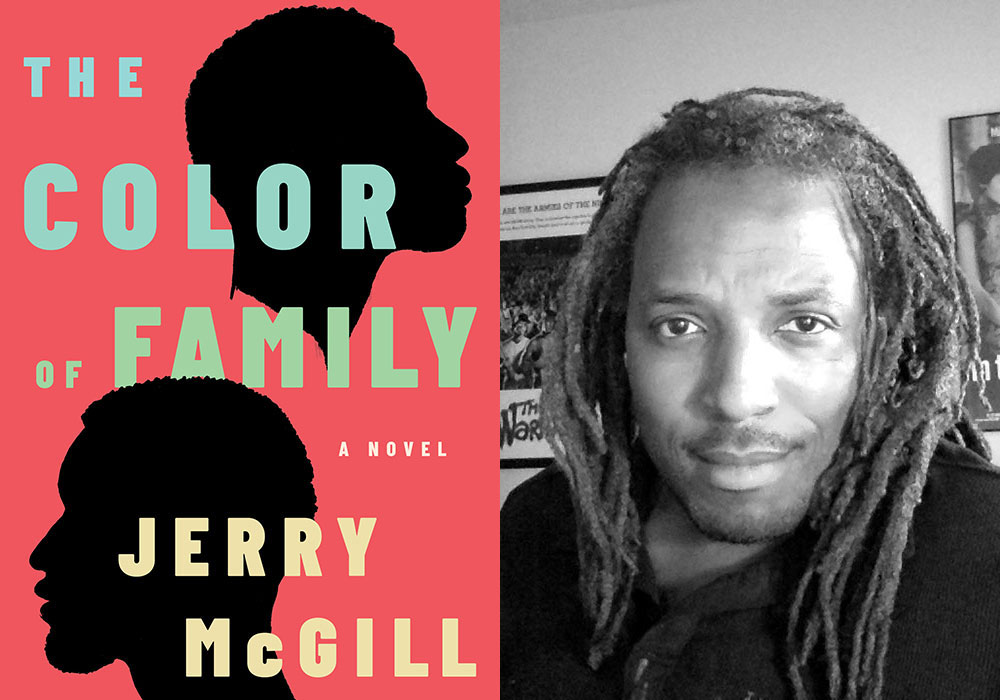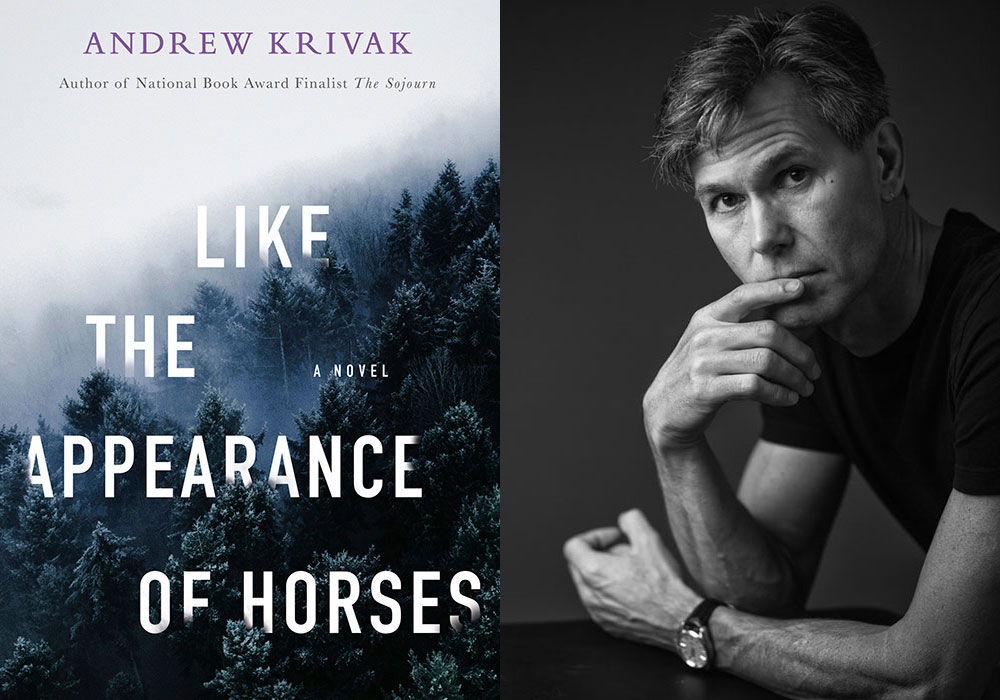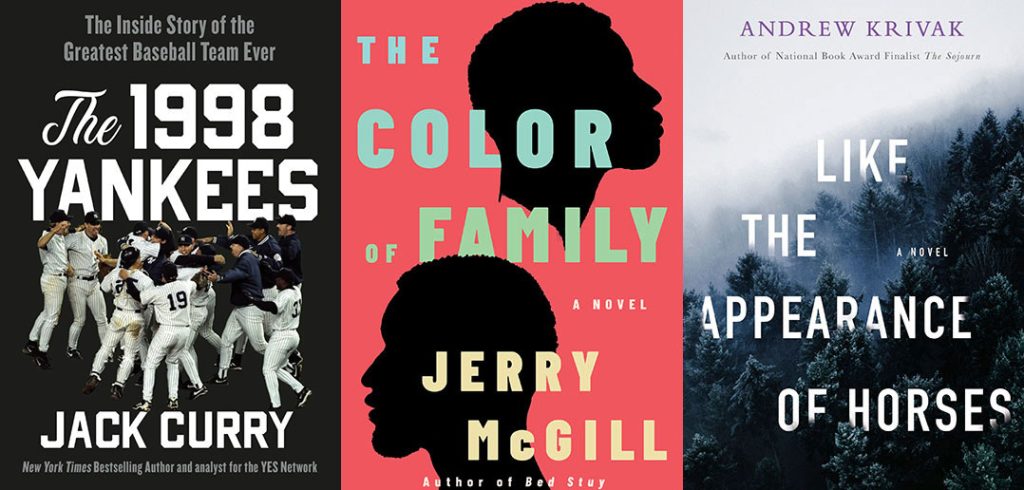Jack Curry’s tribute to the 1998 Yankees, Jerry McGill’s fictional tale of a “large and quirky Black family,” and Dayton Literary Peace Prize winner Andrew Krivak’s latest novel are three alumni-penned titles on our nightstands right now.
Veteran Sportswriter Jack Curry Gives Readers a Behind-the-Scenes Look at ‘The Greatest Team Ever’

When Jack Curry, FCRH ’86, began interviewing players for a book about the Yankees’ 1998 season, he asked Hall of Fame shortstop Derek Jeter to describe the team. “Greatest team ever,” Jeter told Curry. “That’s what comes to mind.” And that’s how the subtitle of Curry’s latest book, The 1998 Yankees: The Inside Story of the Greatest Baseball Team Ever (Hachette, 2023) was born.
Curry has been covering the team for decades. He co-wrote Jeter’s 2000 book, The Life You Imagine: Life Lessons for Achieving Your Dreams, and he’s also written books with former Yankees Paul O’Neill and David Cone. Since 2010, he’s been an analyst on the YES Network, and for more than two decades prior to that, he was a sportswriter for The New York Times, including during the 1998 season.
Now, 25 years later, he takes readers through the team’s incredible 125-win season, from a sluggish 1-4 start through an impressive postseason run that culminated in the Yankees’ 24th World Series title (they’ve added three more since then). And while Curry recounts all the big moments fans know so well, he also peels back the curtain so readers can appreciate the back stories and see how the players—and a dramatic season—came together.
Curry shares how the night before David Wells threw a perfect game, he was out drinking until the wee hours with then-Saturday Night Live star Jimmy Fallon; how a connection General Manager Brian Cashman made the season before helped the Yankees sign a contract with pitcher Orlando “El Duque” Hernández, who defected from Cuba on Christmas Day, 1997; how closer Mariano Rivera came across his signature cut fastball during a game of catch; and how Scott Brosius went from “a player to be named later” in a trade to World Series MVP.
For Yankees fans and baseball fans alike, Curry’s latest book offers a front-row seat to the team’s journey from a heartbreaking playoff loss in 1997 to the top of the world just a year later.
—Kelly Prinz, FCRH ’15
Jerry McGill Explores Family Dynamics, Betrayal, and Forgiveness in The Color of Family
 In his latest novel, The Color of Family (Little a, 2023), Jerry McGill shares a portrait of the Paynes, an upper-class, African American family that lives in suburban Connecticut. Despite appearances, the Paynes aren’t quite as happy as people assume—made all the more evident when twins from France, the result of one of patriarch Harold Payne’s extramarital affairs, arrive on the family’s doorstep.
In his latest novel, The Color of Family (Little a, 2023), Jerry McGill shares a portrait of the Paynes, an upper-class, African American family that lives in suburban Connecticut. Despite appearances, the Paynes aren’t quite as happy as people assume—made all the more evident when twins from France, the result of one of patriarch Harold Payne’s extramarital affairs, arrive on the family’s doorstep.
One fateful night, brothers Devon and James are in a car accident that leaves Devon paralyzed. James eventually goes off to college and excels at the sport they both loved. When Devon is moved into a rehabilitation center across the country, the distance between them—wrought by their explosive, sports-fueled rivalry—is no longer just figurative.
Years later, as Devon travels around the world over the course of a decade to visit his seven siblings, he sees how the traumatic accident of his youth has affected—and connected—them all. They each may have moved on, but it’s only through forgiveness and coming to terms with the past that they’ll be able to live freely in the present.
Though Devon is at the center of the novel, McGill weaves in diary entries and first-person narratives from the other characters, giving readers a chance to examine the relationships, events, and heartbreaks from multiple perspectives. The novel is fewer than 300 pages long, and that, coupled with the shifting points of view, makes it a great, page-turning summer read.
McGill is the author of two other novels, including Bed Stuy: A Love Story, and a memoir, Dear Marcus: A Letter to the Man Who Shot Me. Read our 2012 profile of McGill and review of his memoir.
Award-Winning Novelist Andrew Krivak Evokes the Effects of War on Four Generations of a Pennsylvania Family

The title and epigraph of Andrew Krivak’s century-spanning new novel come from the Book of Joel. Warning of ecological disaster, the biblical prophet compares a plague of locusts to war horses: “Their appearance is like the appearance of horses, and like war horses, they run.”
The proverbial war horses run through each generation of the family at the heart of this lyrical, moving book. Homecomings are both longed-for and fraught, as each generation is haunted by the moral complexities of war, and by their own struggles to survive battles intensely physical and psychological.
The novel begins in 1933, when a teenage Bexhet “Becks” Konar flees fascist death squads in Hungary. He appears at the Dardan, Pennsylvania, homestead of Josef Vinich, who saved his infant life at the end of World War I. Vinich, now co-owner of a roughing mill, treats Becks like a son. Eventually, Becks and Vinich’s daughter, Hannah, fall in love, marry, and have two children, Bo and Samuel, before Becks is sent to fight for his adopted country in World War II.
He returns from the war a shell of his former self, and in 1949 he’s killed in a hunting accident—shot through the chest by Paul Younger, whose father had been forced to sell his land to Vinich years earlier, and whose family becomes even more intimately linked with the Konars.
In the 1960s, Samuel enlists in the Marines, becomes a prisoner of war, and develops a heroin addiction. Both he and Bo eventually learn about their father’s battles in World War II, which include a charge of desertion, imprisonment, and a bloody stint as part of the Romani resistance.
From one generation to the next, peace is elusive. And while Krivak depicts the violence of war with frightening intimacy, he’s also attuned to the persistence of beauty and grace in nature and in what love endures.
In 2012, when Krivak received the Dayton Literary Peace Prize, which recognizes “the power of the written word to promote peace,” he dedicated the award to the people who shaped him, including his immigrant grandmother, whose stories about life in what is now Slovakia continue to inform his fiction.
“They’ve all done their work. They’ve all found their peace,” he said in an acceptance speech. “What remains is for us to keep telling of it as well as to keep praying for it, to keep insisting upon it as well as to keep hoping for it, and to keep listening so that we’ll know when to act, whether it’s out in the world … or at work on a sentence, alone in a room with words.”
Like the Appearance of Horses (Bellevue Literary Press) is the culmination of Krivak’s Dardan Trilogy, a saga that began with his 2011 debut novel, The Sojourn, which focuses on Josef Vinich’s experiences as an Austro-Hungarian conscript in World War I. Each book in the series, which also includes 2017’s The Signal Flame, can stand on its own.
Krivak is also the author of the 2020 novel The Bear (read an excerpt), a collection of poetry, and A Long Retreat: In Search of a Religious Life, a 2008 memoir about his eight years as a Jesuit.
—Ryan Stellabotte

